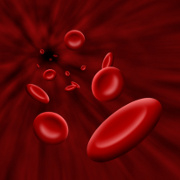One of the great benefits of being a health advocate is that with each article, I learn something new. Most of the time, this knowledge becomes great trivia, tucked safely away in my mental filing cabinet under the things-to-remember-just-in-case category.
Every once in a while, life happens and I find myself frantically scrambling through the layers of dust, grateful the just-in-case file is still intact. Such was the case recently when our family experienced our own real life reality check with deep vein thrombosis, or DVT.
The DVT adventure began when my husband finally admitted something was wrong and went in for tests to see what was going on with his veins. He learned -- despite his denial -- that he was no longer bullet-proof, when the technician came in announced that he had a DVT and that they had called an ambulance.
Despite a love of fast cars, he declined their kind offer for a high speed ride to the hospital. Lest the naughty boy try to hide it from me, his doctor called me at home to stress how serious DVT was and that he needed to come to the hospital right away.
Fortunately, we were very lucky. Thanks to EmpowHER, my filing cabinet was full of information on DVT that helped us navigate some of the decisions that had to be made rather quickly. Not everyone is so fortunate.
Below you’ll find some basic information about DVT. While not meant to be exhaustive, the information may come in handy if you’re ever faced with your own DVT emergency.
What is DVT?
In its simplest terms, a DVT is simply a blood clot, also referred to as thrombosis, which occurs in one of the deep veins of the body hence the name deep vein thrombosis. While it can occur in any deep vein, it’s frequently found in the deep veins of the legs.
Why is DVT so serious? What are the side effects?
DVT is an extremely serious and life-threatening condition. If the blood clot dislodges, it can travel to the lungs and cause a pulmonary embolism which may lead to low oxygen levels, pulmonary hypertension, damage to other organs in the body, and death.
Symptoms of pulmonary embolism include conditions such sudden shortness of breath, rapid pulse, sweating, chest pain that is worse when you take a deep breath, coughing up blood, and feelings of anxiety. Persons experiencing symptoms of pulmonary embolism should seek medical attention immediately.
What are DVT symptoms?
DVT has several distinct symptoms including swelling in the leg, ankle or foot, pain or cramping in the leg, a feeling of warmth or heat over the area where the thrombosis is located and changes in skin color to a blue, red, or pale color.
Unfortunately, not everyone is symptomatic. About half of all people with a DVT don’t experience any symptoms.
Who is at Risk for DVT?
Sometimes, DVT may be caused when you sit for long periods of time. Persons who travel sometimes experience DVT.
Medical conditions such as inherited blood clotting disorders, pregnancy, inflammatory bowel disease, heart failure, and some cancers may lead to the development of DVT. Other contributing factors to DVT include prolonged bed rest, surgery, medications such as hormone replacement therapy or birth control pills, and insertion of a pacemaker.
Family history plays a role in DVT as does lifestyle factors such as obesity, smoking, and age. Taller men also have a greater risk of DVT than shorter men.
How is DVT diagnosed?
Several diagnostic tools are available to help diagnose DVT:
• Blood test: Most people with DVT have elevated levels of D dimer in their blood. D dimer is a clot-dissolving substance. The presence of D dimer is used to rule out DVT and to diagnose how likely you are to have a reoccurrence of DVT.
• Ultrasound: An ultrasound is a test where a wand is moved over the affected area and transmits sound wave images back to a screen.
• Venography: This test is conducted by injecting a contrast agent or dye into the large vein in your foot or ankle. A procedure similar to an X-ray is conducted to create a picture of the veins in your legs and feet.
• CT or MRI scans: These scans create visual images of the veins.
How is DVT treated?
When treating DVT, physicians need to treat three primary areas. Firstly, they need to prevent the clot from becoming bigger. Secondly, it’s important to take steps to prevent the clot from dislodging and traveling to the lungs where it may result in a pulmonary embolism. Thirdly, physicians will want to make certain you don’t have a reoccurrence of DVT.
• Blood thinners: One way DVT is treated is with blood thinners such as warfarin (Coumadin). In most cases, DVT patients will be given injections of heparin as well as oral blood thinners. Taking blood thinners require a delicate balance -- the blood needs to be thin enough to prevent clots but not so thin that you develop bleeding problems. As a result, you will need periodic blood tests.
• Clotbuster: If blood thinners don’t work, your physician may prescribe a "clotbuster" medication. Clotbusters are part of the thrombolytic family of drugs and are administered intravenously.
• Vena Cava Filter: Persons unable to take blood thinners may need a vena cava filter inserted into the vein. The vena cava filter is umbrella shaped and designed to catch the clot if it dislodges so that it can’t travel to the lungs.
• Graduated Compression Stockings: Compression stockings may be prescribed to help prevent swelling associated with blood clots and reduce the risk of reoccurrence. These are generally worn for at least a year.
Sources:
Deep Vein Thrombosis. The Mayo Clinic. 05 Aug 2011. http://www.mayoclinic.com/health/deep-vein-thrombosis/ds01005
What is Deep Vein Thrombosis? National Heart Lung and Blood Institute. 28 Oct 2011. http://www.nhlbi.nih.gov/health/health-topics/topics/dvt
What is Pulmonary Embolism. National Heart Lung and Blood Institute. 01 Jul 2011. http://www.nhlbi.nih.gov/health/health-topics/topics/pe
Reviewed April 2, 2012
by Michele Blacksberg RN
Edited by Jody Smith




Add a CommentComments
There are no comments yet. Be the first one and get the conversation started!